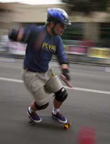Ah, that's a really cult Slalom! article. It was really fun to read it again too. Funny also that I called my self "an oldtime skater" already then in 1994. Seems like the old-school term had not been invented yet?
Actually I had to search in my drawers for that Slalom! magazine to read more of that article because it didn't seem correct. There is nothing in the ISSA rules that stops you from changing the distance of the last cones before the race. Did I really write that? After finding the mag and reading the article I got it. Vlad your quote was not exactly correct. This was not the "Special slalom course", it was the parallell slalom or double slalom that the Italians called it for some reason. I forgive you though, Vlad, since it is true that the text was not extreamly clear on this.

For parallell slalom the rules are...
2.1 The first cone shall be placed no closer than 4 meters from the starting ramp.
2.3 Each course shall consist of a series of cones placed in a straight line. The distance between cones shall be 1.7 m (measured from center to center).
2.5 The number of cones should be exactly 36.
2.6 The finish line should be placed 0.5 meter after the last cone, thus creating a course of exactly 60 meters.
When reading the rules you understand why you can't change the cone distances. They are very hard and clear.
- "The first cone shall be placed no closer than 4 meters from the starting ramp"
- "The distance between cones shall be 1.7 m"
- "The number of cones should be exactly 36"
- "The finish line should be placed 0.5 meter after the last cone"
This was all so detailed and fixed to create a course that would be the same everywhere and so that you could compare results over time and between different competitions. The first cyber slalom idea I guess. There where no rule about running it on the flat here though.
The course was always exactly 60 meters (4m before first cone + 35x1.7 cone distances + 0.5 meter after the last cone).
So that was why it was such a big deal changing the distance and by doing so breaking the ISSA rules. And now when thinking more about it that is why the result list names it as "Double slalom" and not "Parallell slalom". Oh, yes! Wasn't that clever. Solved the whole problem without making a big fuss about it. A little diplomatic protest only to be noticed by those who cared about it. I bet everybody now reading it will just react like I first did. Ha, ha, those funny Italians calling the parallell slalom "Double slalom". Isn't that a funny little story for the Slalom History Archive?








